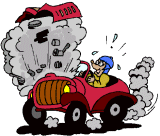
Cars

The motor vehicle engine emits many types of pollutants including nitrogen oxides (NOx), volatile organic compounds (VOCs), carbon monoxide (CO), carbon dioxide (CO2), particulates, sulphur dioxide (SO2) and lead. Emissions of such pollutants may lead to poor air quality, posing environmental and health risks. Individually, a vehicle engine is not a particularly important source of pollution. Collectively however, they represent a major source of air pollutants inmost developed countries, including the UK.
Emissions are related to use of the engine, mainly the fuel type and the temperature of fuel combustion. If the engine is efficient, then the products of combustion will be mainly carbon dioxide and water. However, at low speeds and idling engines are inefficient and therefore the products of incomplete combustion dominate, for example carbon monoxide and VOCs from petrol engines, and carbon monoxide, VOCs, particulates and smoke from diesel engines. As the temperature of combustion increases, the efficiency of conversion to carbon dioxide and water increases. However, impurities in the fuel such as nitrogen are oxidised to nitrogen dioxide. At high temperatures atmospheric nitrogen (N2) is also oxidised to nitrogen dioxide.
Nitrogen oxides pollution from vehicles can be significantly reduced by fitting a catalytic converter to the exhaust system. This is a relatively low cost method of pollution control (around £350) which has little effect on vehicle performance and fuel consumption. All new cars sold in Britain from January 1993 onwards have catalytic converters.
Diesel fuel contains more energy per litre than petrol and coupled with the fact that diesel engines are more efficient than petrol engines, diesel cars are more efficient to run. Diesel fuel contains no lead and emissions of the regulated pollutants (carbon monoxide, hydrocarbons and nitrogen oxides) are lower than those from petrol cars without a catalyst. However, when compared to petrol cars with a catalyst, diesels have higher emissions of nitrogen oxides and much higher emissions of particulate matter.
Emissions from cars are greatest when an engine is cold. On a cold day a petrol car may take up to 10km to warm up and operate at maximum efficiency; a diesel car may only take 5km. Consequently, diesel cars produce less unburned fuel during a cold start, which will result in lower emissions of carbon monoxide and hydrocarbons. Diesel cars could make a significant impact on air quality in urban areas where most cold starts occur, especially when it is considered that a catalyst on a petrol car would take several minutes to reach its operating temperature. Overall, diesel cars emit less hydrocarbons, carbon monoxide and lead pollution than petrol cars, but produce more noxious gases and significantly more particulates.
Websites
Other topics
• NSCA
• NETCEN
• US EPA
• US EPA
• US EPA
• Environmental Center
• Introduction
• Asthma
• Carbon Monoxide
• Cars
• CATs
• Chemistry
• Cities
• Clean Air Acts
• Cleaner Fuels
• Countryside
• Dispersion
• Doing Our Bit
• Dustmite
• Emissions
• Fossil Fuels
• History
• Human Health
• Impacts
• Indoors
• Industry & Power
• Legislation
• Lichens
• London Smog
• Management
• Measuring
• Megacities
• Modelling
• Monitoring
• Mould Spores
• Natural Sources
• Nitrogen Dioxide
• Outdoors
• Ozone
• Particulates
• Pollutants
• Radon
• Smog
• Smoke
• Smoking
• Standards
• Sulphur Dioxide
• UK Air Pollution
• UK Strategy
• Vehicle Controls
• VOCs
• Wildlife
 Print Topic
Print Topic